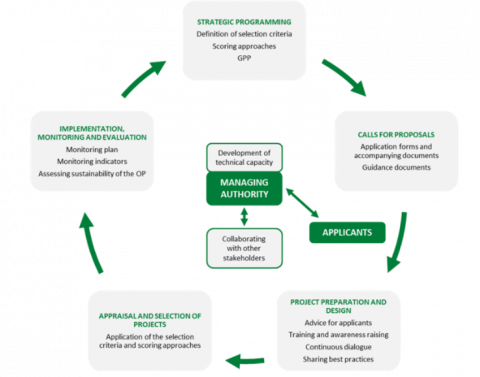Integrating environment into European Structural and Investment Funds

One of the main concrete and practical ways to strengthen the environmental component in EU-funded projects is through using innovative selection criteria for the environment in a consistent and targeted way. The recently released DG Regional and Urban Policy study proposes numerous examples and ideas on how to do that in practice. The study, carried out by COWI A/S and Milieu Ltd., is a follow-up of a 2019 research on better integration of environment into Cohesion policy featured in Policy Learning Platform news.
Currently, EU Member States and regions are busy with programming the investment framework for the new programming period of the European Structural and Investment Funds (ESIF) 2021-2027.
Environment is set to take a more prominent role in the expenditures through higher climate goals, circular economy and climate neutrality ambitions, to name but a few. At the same time, the EU Green Deal proposes a set of policies which might transform the European economy and society in the coming decades.
How to strengthen the environmental component in EU-funded projects
The environmental pillar in ESIF-funded projects can be strengthened in a number of ways, through interventions at different stages of the project cycle (see figure). The challenge is to programme as many direct environmental projects as possible (vertical integration) and, in parallel, to mainstream environment into non-environmental projects of Operational Programmes (OPs) (horizontal integration).
Mainstreaming environment in projects can be done through adapting the design of the calls for proposals. For example, using Green Public Procurement (GPP) as an eligibility criterion is one way to trigger an offer of greener products and services.

Selection criteria
Designing more ambitious selection criteria with regards to environment and climate is an excellent way to channel European funding. The study recognises that the Strategic Environmental Assessment (SEA) of an Operational Programme can be instrumental in improving environmental criteria and should be taken in serious consideration by Managing Authorities (MAs), which is not always the case. Another important possibility for the MAs to boost the environment in EU-funded projects is through preparing a methodology and criteria for the selection of operations. Defining suitable project selection and project appraisal criteria is another strategy for enhancing the environmental component of projects. In practice, project selection criteria are eligibility criteria (i.e. energy and resource efficiency) while quantifiable project appraisal criteria help guide the project preparation and assessment process.
Why is this study important for Managing Authorities?
When implementing EU projects in practice, MAs need concrete tools and ideas for minimising the negative environmental impacts of some categories of projects (i.e. transport) and for maximising the positive impact of other types of projects (e.g. large infrastructure projects, construction of buildings, trainings, etc.). The study gives ample and concrete examples of project selection criteria as well as practical illustrations of their implementation through case studies.
For further information, the topic of Green Public Procurement (GPP) has also been tackled recently in a webinar on innovative GPP approaches by the Policy Learning Platform.
Other literature on the topic
- ENEA-MA report on 'Mainstreaming the environment in cohesion policy in 2014-2020', 2016
- Study on Integration of environmental concerns in Cohesion Policy Funds, 2019.
